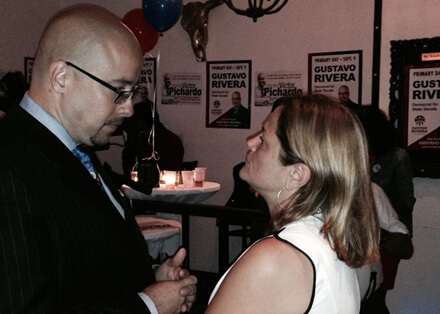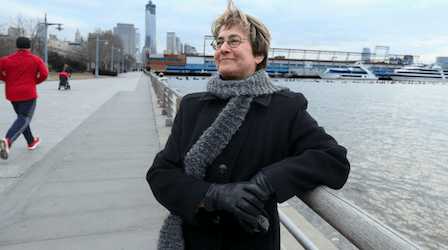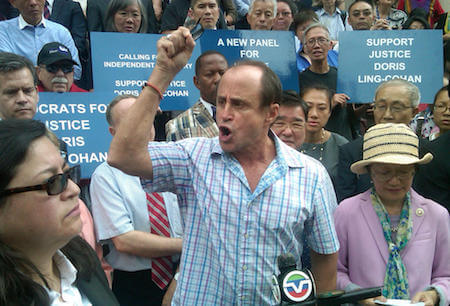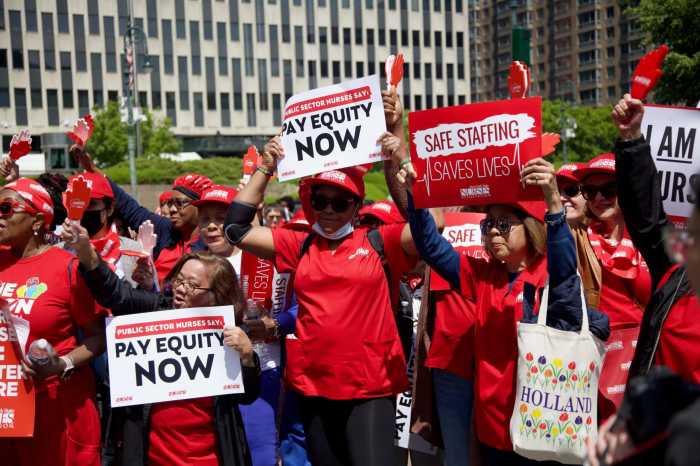A new survey-based assessment of the educational, employment, income, housing, and health status of transgender residents of New York State demonstrates startling disparities in their well-being, even when compared to other segments of the LGBT community.
Among the findings was evidence that the transgender portion of the queer community is 50 percent more likely to be in poor or only fair health, 150 percent more likely to have a history of homelessness, twice as likely to live in poverty, and three times more likely to have less than a high school education — all by comparison to lesbian, gay, and bisexual respondents.
“This data is not something we didn’t know, this is our community,” said Carrie Davis, a transgender woman who is the chief programs and policy officer at the LGBT Community Center, where the report was announced on November 20. “But what always strikes me when I look at data like this is how extreme the disparities are.”
Findings, produced by Pride Agenda, State AIDS Institute, point up social, economic, health barriers
Though the picture the new report paints is not necessarily different than what advocates like Davis see in their everyday work, the size of the survey sample and specificity of its findings could prove a powerful policy tool for advancing important government and social service interventions.
“We are always asked to provide specific data,” said Matthew McMorrow, director of government affairs at the Empire State Pride Agenda (ESPA), one of the lead players in putting the report together. “Bringing personal stories and anecdotal evidence is good, but when we can actually bring numbers to the legislators, it makes them better advocates.”
The report, produced by the Strength in Numbers Consulting Group, on behalf of ESPA, the New York State LGBT Health and Human Services Network — a group of 54 non-profit organizations statewide coordinated by ESPA — and the AIDS Institute within the state’s Department of Health, was part of a larger study examining the health and social well-being of the state’s LGBT population. A total of 3,792 self-identified LGBT people made up what is known as a “convenience sample,” meaning they stepped forward to participate, rather than being identified randomly. Of that total, 583 respondents identified as transgender. (Another 295 respondents who identified as gender nonconforming but not transgender were not included in this report, but will be discussed in future reports based on the data collected.)
The findings demonstrate that across a broad array of social, economic, and health outcomes, the transgender community in New York faces significantly more serious challenges than the rest of the LGBT community.
Not only are transgender New Yorkers over the age of 24 three times more likely to have less than a high school education, they are also only half as likely to have a college degree. Regardless of whether they have completed college, they are twice as likely to be unemployed and 140 percent more likely to be living in poverty, as compared to other LGBT New Yorkers. Among transgender respondents of all ages, they are twice as likely to live in poverty as their LGB peers.
The transgender community also faces significant housing barriers, being 150 percent more likely to have a history of homelessness and twice as likely to currently be homeless. Among those in stable housing, transgender respondents are two-thirds less likely to own their homes. More than 10 percent say they were denied housing because of their gender identity and expression, and more than a quarter reported being harassed by neighbors.
The educational, employment, and housing barriers the transgender community faces have important health impacts. Nearly half of all respondents indicated they are “food insecure” — meaning they have difficulty affording nutritional meals on a consistent basis. Transgender New Yorkers are three times more likely to report having inadequate health insurance, which likely contributes to the fact that they are 50 percent more likely to rate their health as poor or only fair, as compared to others in the LGBT community. They are also more than 50 percent more likely to report experiencing depression.
Stark as these findings are, they may underestimate the degree of the disparities. The fact that the sample was one of “convenience” rather than random means that it is likely that the most marginalized portion of the community did not participate, the report notes. The transgender respondents were 85 percent white and nearly 70 percent of them lived outside the five boroughs, which means that people of color in the city — who bear some of the gravest disadvantages — were underrepresented in the findings. In all reliable data on anti-transgender hate crimes, people of color, particularly women, make up the overwhelming majority of the victims.
The Center’s Davis said that the most important contribution of the new report is its focus on the “social determinants of health outcomes.” If transgender health is thought of as a “cascade,” she said, there are a series of “disruptions” — educational disadvantages, lack of employment, poverty, and homelessness — that lead to health problems.
Most studies on transgender health, Davis noted, focus on the prevalence of HIV, driven by the need to engage in survival sex for employment. But when asked what the most effective way to tackle the HIV crisis is, Davis said, she responds, “Get them jobs. Economic insecurity leads to HIV risk.”
And it is that insecurity, and not HIV specifically, that is topmost on the minds of transgender people, she said.
“When I do focus groups with trans people, they don’t talk about HIV much,” Davis said. “They talk about getting jobs.”
Then, in a cautionary note about the prospects for ending the AIDS epidemic by 2020 — something advocates, the state, and the city are all striving for — Davis said, “We’re not going to get there with PrEP alone, as long as people seek purposeful sere-conversion as a way to access benefits.”
During the press event announcing the report, Daniela Simba, a trans woman who now works at the Apicha Community Health Center, spoke about the job hurdles she faced when she first completed her education. She lost out on one job, she was told, because of her “sexual orientation,” a clear sign, she said, that too many people remain in the dark about what being transgender even means.
Discrimination, of course, is central to all of the report’s findings, and frustration with achieving a statewide civil rights law protecting the transgender community led to Governor Andrew Cuomo’s recent announcement that the State Division of Human Rights would now interpret nondiscrimination provisions based on sex and disability to cover instances of anti-trans bias. Still, as Davis noted, 50 years of federal protections based on race and sex — not to mention 13 years of transgender protections in New York City — have not conquered discrimination.
From the Center’s perspective, the most important immediate objective is helping prepare transgender people for those employment opportunities that do exist.
“We need to find employers who want to take a leadership role, similar to what we do with LGBT youth,” Davis said. “But opportunities won’t help if you’re not prepared. We need to work with people to populate their résumés, learn how to interview, and catch up with their education. It’s about taking responsibility for their own lives, which I think they are already doing.”
The Center is about to roll out an employment readiness program for its transgender clients. For now, as with many start-up initiatives, the effort is funded by private donor support, but government funders will certainly pay attention if the program can demonstrate results.
All of which is helpful for other advocates, like ESPA’s McMorrow. He said that the Legislature’s support for the LGBT Health and Human Services Network has been steady in recent years at just under $5 million, with the AIDS Institute kicking in several hundred thousand dollars more. The overall study that Strength in Numbers produced could be helpful in trying to grow that funding level in the future.
Given that the funding is spread over 54 groups statewide, McMorrow did not have a ready answer on how much of the $5 million serves transgender New Yorkers, but he said the results of the current report make clear that “a larger proportion should go to transgender services.”
Several legislators on hand when the report was announced on November 20 spoke to its significance.
“This study is really profound,” said State Senator Brad Hoylman, an out gay West Side Democrat. “These statistics really give power to us to understand why so many transgender people are treated the way they are because they are disempowered. This is going to be very important as we start the budget process.”
Hoylman’s view was echoed by West Village Assemblymember Deborah Glick, an out lesbian Democrat, and the two Democrats who sponsor the Gender Expression Non-Discrimination Act, Chelsea Assemblymember Dick Gottfried and Lower Manhattan-Brownstone Brooklyn Senator Daniel Squadron.
What comes next in the effort to enact GENDA is unclear. Gottfried is the most adamant about the need to keep pushing, noting that Cuomo’s order could potentially be undone by a future governor and that the new interpretation of the Human Rights Law does not extend protections under the state’s hate crime law to the transgender community.
Nobody has contradicted Gottfried in his continued commitment to GENDA, but others have emphasized both the strength of the governor’s recent action and the need to focus advocacy efforts on what can be achieved.
“I’m really impressed with the power of the governor’s order,” the Center’s Davis said. “I want to look at what is there, how easily can it be overturned. Wouldn’t it be foolish to do otherwise?”
Still, she acknowledged that the legislation remains an important goal.
“We haven’t been able to pass GENDA and that’s hurtful,” Davis said.
McMorrow at ESPA captured the essence of what many are saying about GENDA’s future.
“I think generally everyone says GENDA should pass,” he said, but the immediate concern is protecting the governor’s action, which he described as “a big leap for transgender rights.” ESPA is urging allies and advocates to register their support for the new regulations during the Division of Human Rights’ public comment period that ends in mid-December.
Saying “we are not abandoning” GENDA, McMorrow acknowledged that as long as the Republicans keep control of the State Senate, the terrain “does not seem fertile.” For 2016 advocacy efforts on behalf of the transgender community, he said, the key question is establishing “priorities.”





































